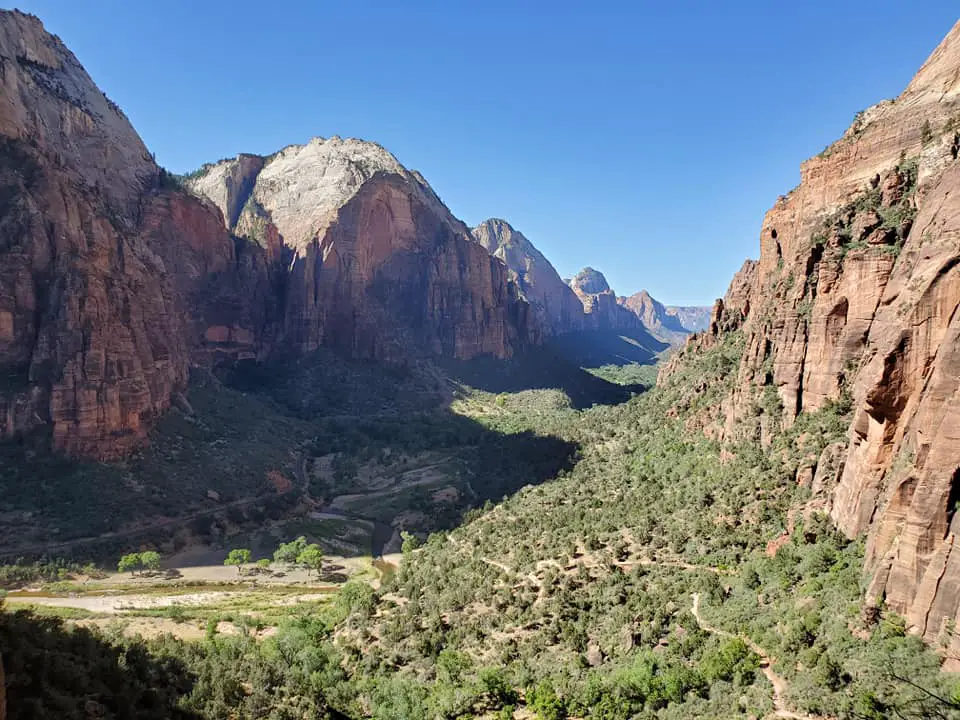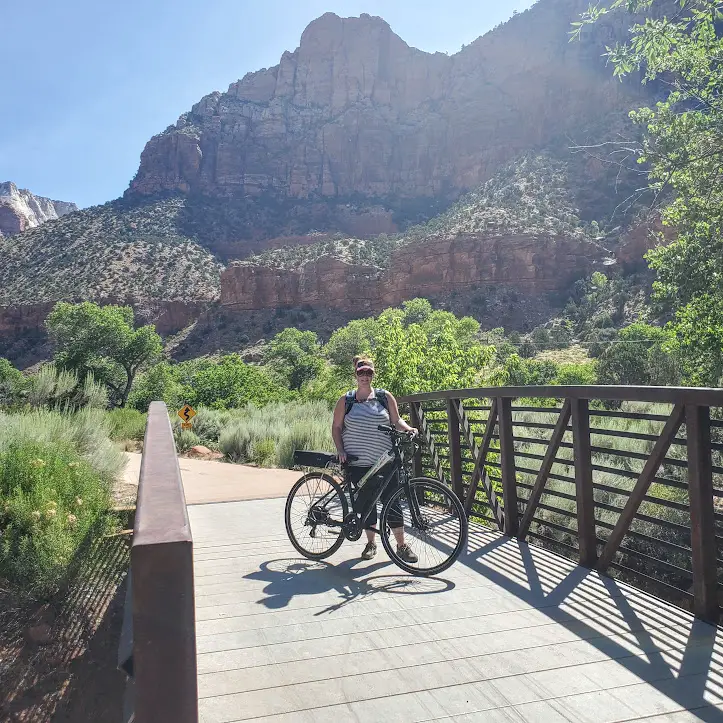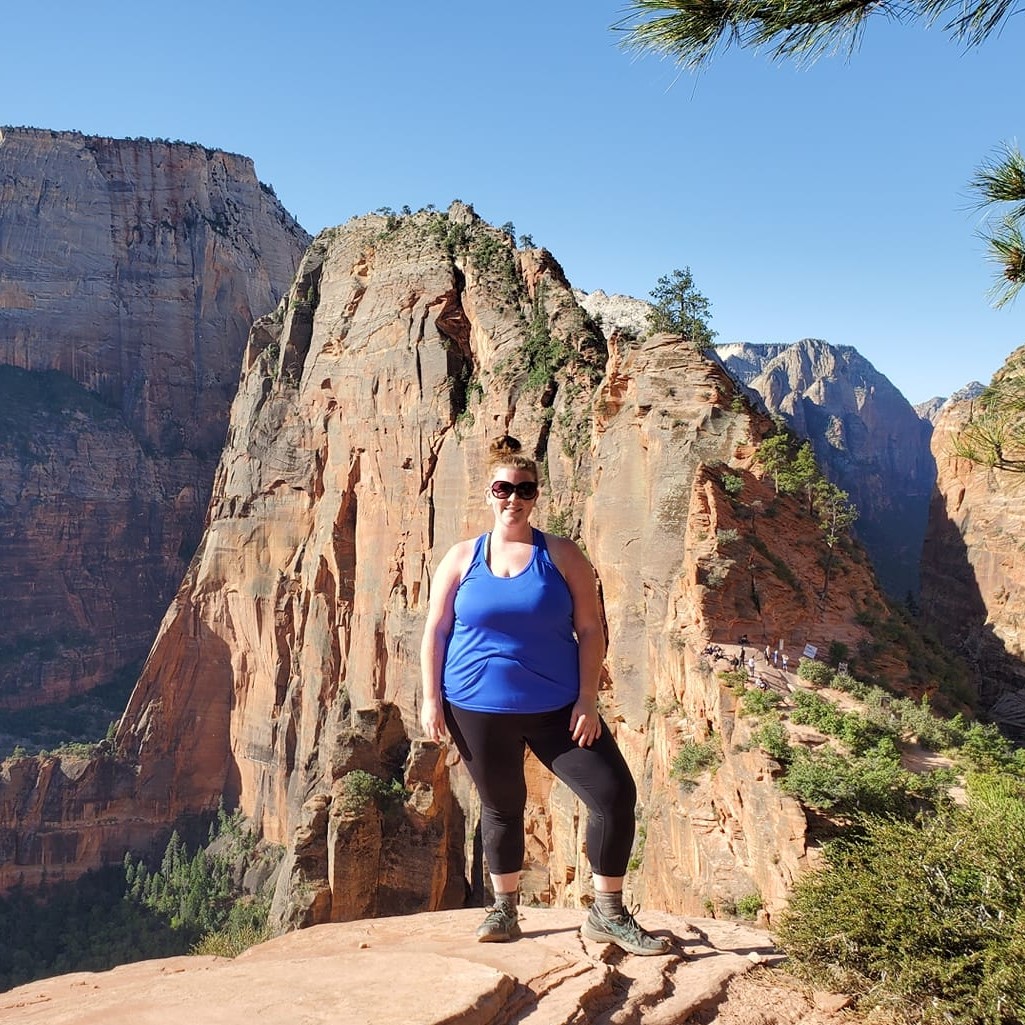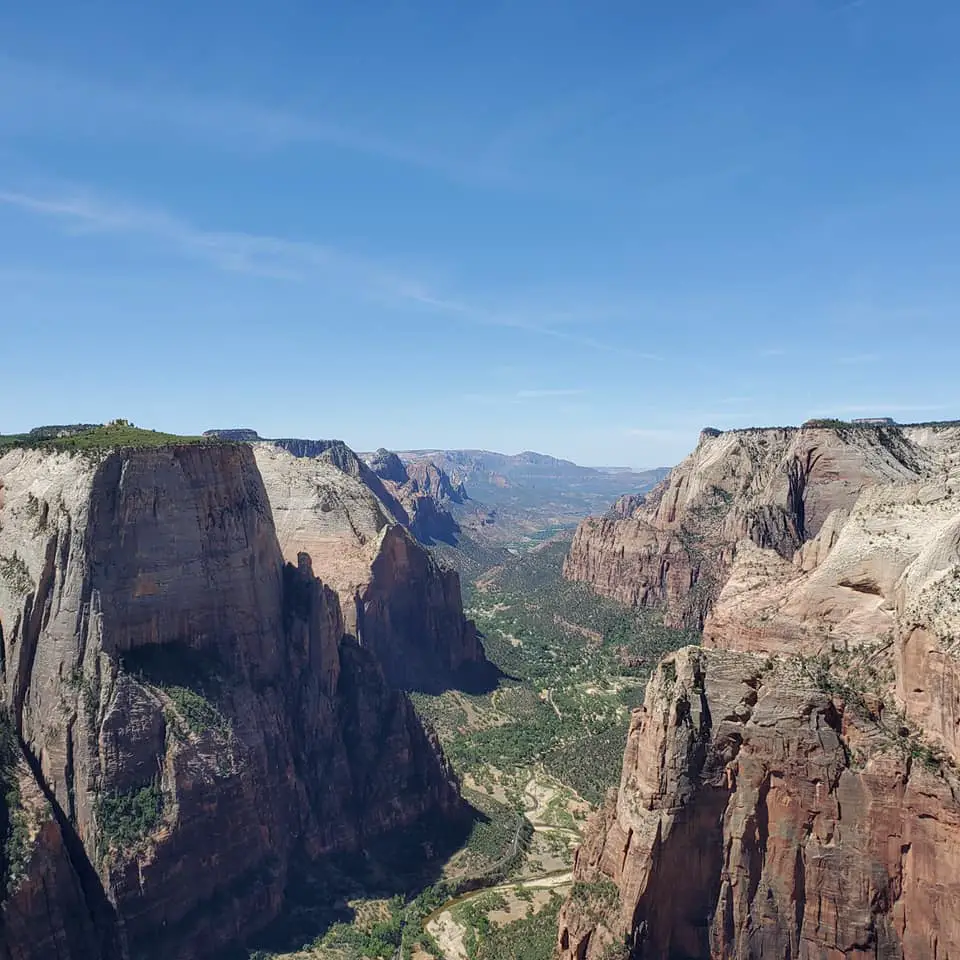
Getting to Zion
There are a number of ways to get to Zion. I recommend flying into Las Vegas (LAS). It is the cheapest option and only a 2 hour and 45 minute (absolutely beautiful) drive into Springdale, UT. You can also fly into a few other major airports like Salt Lake City (SLC) which is a 4 hour and 20 minute drive, or Flagstaff (FLG) which is a 4 hour and 30 minute drive.
There are 3 entrances, but the South entrance is the most popular, nearly 2/3rds of all visitors visit Zion via the town of Springdale.
Rt. 9 (West Entrance)
Kolob Canyons (East Entrance)
Springdale (South Entrance)
Fees & Cancellation Stamp
It cost $35 per private vehicle, which is good for 7 consecutive days. However, if you are driving through the area or maybe doing a day trip from Vegas, you can park in Springdale and walk through the entrance gates, which only costs $20. An America the Beautiful pass gets you in for free. I highly recommend this pass if you are going to see more than one of the Utah parks.
You can get your cancellation stamp at the main visitor center in Springdale. I’m sure the entrance booths at the East and West entrances have them, but I cannot 100% confirm.
Time Required in Zion
This depends on your whole-trip itinerary and what exactly your priorities are. I’ll break it down by scenario as best as I can. Check back for 1, 2, 3, 4, and 5 day itineraries!
1) Staying in Vegas and want to visit Zion: 1 full day
2) Priority is the Grand Canyon but you have some flexibility to visit Zion: 2 full days
3) Want to see Zion but are visiting all of the Mighty 5: 2 full days
4) Taking a two week road trip and have some time to work with: 3 days
5) Only going to Zion but on a budget: 3 days
6) Combining Zion with Bryce Canyon: 4 days in Zion, 3 days in Bryce Canyon
7) Only going to Zion and want to do as much as possible: 7 days
Camping in Zion
Watchman Campground is the most popular. It is right at the front of the South entrance and features both tent sites and RV sites with electric hookups, as well as bathrooms. Electric sites run $30 a night and tent sites run $20. Many sites are up against the North Fork River and offer gorgeous views of the canyon as a backdrop to the river. It is also within walking distance the visitor center and several family friendly hiking trails.
South Campground is also inside the park near the visitor center, but is a little smaller and does not offer electric hookups or bathroom facilities. Sites for either RVs or tents go for $20 a night.
Lava Point Campground is located in the Kolob Canyon area (about 1.5 hours from the South entrance) and has a handful of first come, first serve sites. However, due to increased visitation, the NPS is considering making it reservation only for the 2022 season like the other two campgrounds.
I considered camping for my visit, but ultimately chose to stay at a hotel in Springdale. I knew I would finish hiking each day by early afternoon. It would have been too hot during all that down time to enjoy myself with no way to cool off. Not only that, but unless you have experience flying your camping gear, you would have to rent everything which can get really expensive.
Lodging inside Zion National Park
There is one lodging option inside Zion, which is Zion Lodge. They offer motel rooms, cabins, and suites. There is also a gift shop and post office. Food options include a sit down dining room, or a cafe that serves cafeteria style food to both guests and other visitors to the park. Zion Lodge can be a little pricey, but people find it’s convenient location worth it.
Lodging in Springdale

The town of Springdale is absolutely adorable and has many, many options for sleeping, eating, and shopping. I’ll talking about popular lodging options here, but check out my separate Springdale page for food and shopping recommendations.
I stayed at La Quinta Inn & Suites (pictured above), which I highly recommend. I picked it for the pool, which exceeded my expectations. There are cute fountains and a few cabanas with plenty of lounge chairs. In addition to bathrooms and showers, they provide a separate pool towel service. There is a breakfast buffet that I assumed has resumed since my visit during Covid in June 2020.
Other Popular Lodging Options
Flanigan’s Inn
Zion Canyon Lodge
Holiday Inn Express
Red Rock Inn
Desert Pearl Inn
Getting Around Zion
How to get around Zion largely depends on your sleeping accommodations. In pretty much every scenario you will need to use the shuttle. However, if you stay at the lodge inside the park, that may cut down on how much you need to shuttle. Camping is a guaranteed way to have a parking spot inside the park. The visitor center fills up by mid-morning, in which case you would need to pay to park in Springdale and either walk or shuttle in.
Zion Shuttle
There are actually two separate shuttles, one for the town of Springdale, and one for the park itself. The map below shows all the shuttle stops for Zion Canyon. You can drive your car as far the split to “Zion-Mount Carmel Highway.” At that point you must bear right to Mount Carmel Highway, or U-turn back to the Visitor Center.

The shuttles are in full operation from about mid-February to November. On holiday weekends from November to February they will pull a few out to help ease traffic. When the shuttles are operating you are not allowed to drive your car in the canyon (at least not past the Mount Carmel junction).
I visited in June 2020 when the shuttles were temporarily shut down and I was able to drive my car up and down the main canyon at any point in the day. This was an amazing perk and definitely added to my experience. Unfortunately, that means I’m not too familiar with them, but I do know that the lines get long fast. If you want to get to popular destinations like Angel’s Landing or The Narrows, you will need to get in line very early in the morning.
Zion National Park Must-do’s

Most of what I recommend is hiking because there isn’t a ton to do otherwise. However, in this section I will give a few ideas of activities that do not require hiking.
- Spend time at the visitor center looking at all their informational signs. Also, consider participating in any ranger-led talks or activities.
- Rent a regular or e-bike from Zion Adventure Company and bike the entire 17.5 mile canyon, The e-bikes have pedal assist which makes it extremely easy and so much fun.
- Drive as far as you want down Mt. Carmel Highway, which includes driving through the famous Zion tunnel (beware of vehicle height restrictions!). There are many places to pull over for photos and you should see some wildlife.
- Rent tubes from Zion Outfitters and do the 2 mile float on the Virgin River. This is offered May-July for $25 a person, but only when water levels allow. If levels are too high they will not open.
- Go horseback riding through Canyon Trail Rides. The cost is $50 for 1 hour or $100 for 3 hours, ages 7+
- Go climbing and/or canyoneering. Many places in Springdale offer gear rentals. Permits through the NPS are required.
Hiking in Zion National Park
Click here for a full list of all the hikes in Zion. I will review all the hikes I completed on my trip, listed in the order they go up the scenic drive.
Watchman Trail

Distance: 3.3 miles (Moderate) – Out & back
Review: I did this as a sunset hike, and even though the sun set to my right behind the canyon, the sky was still absolutely beautiful. It’s fairly easy and good for families. There is a ton of room at the end to sit and get pictures looking out over Springdale.
Pa’rus Trail

Distance: 3.5 miles (Easy) – Out & back
Review: Technically I biked this trail, but I recommend walking it in the early morning or evening hours before all the bikers are out. It’s up against the river and you can get some amazing pictures. It’s flat, paved, perfect for families with young kids in strollers.
Emerald Pools – Upper & Lower

Distance: ~4 miles round trip (Moderate) – Out & back
Review: When I visited in June 2020, middle pools was closed due to rock fall. The Lower Pools didn’t have much water. The Upper Pools had water at the base, but there no waterfall. This was a good hike and I’m glad I did it, but I didn’t start until noon. It was incredibly hot and there is not much shade at that time of day since the sun is directly above you. If you do this hike in the morning it would be perfect.
Scouts Lookout via West Rim Trail (Angel’s Landing)

Distance: 3.6 miles (Hard) – Out & back
Review: This is the trail you take to do Angel’s Landing. Unfortunately, the actual Angel’s Landing trail (otherwise known as the “chain’s section”) was closed during my visit. I hiked up to Scout’s Lookout, which is at the base of “the chains.” Then, I decided to hike another half mile up the West Rim Trail to the next lookout, which I 100% recommend doing. It’s a better view, there are less people, and you can get some good shots of Angel’s Landing directly behind you. At Scout’s Lookout you can’t see Angel’s Landing as a whole.
The Narrows via Riverside Walk

Distance: Varies (Hard) – Out & back
Review: This is the last stop on the shuttle, Temple of Sinawava. You have to do the Riverside Walk to enter The Narrows which automatically makes your “hike” 2 miles. How far you go in The Narrows is up to you. I went to the Wall Street/Orderville split and walked about a half-mile up Wall Street. My whole day was about 9.5 miles. There is no elevation gain, but walking against the current in the river is hard. It is an incredible hike and was the highlight of my trip. See below for more info on The Narrows.
Observation Point via East Mesa Trail (Boundary hike)

Distance: 7 miles (Moderate) – Out & back
Review: The only way to do this hike is via the East Mesa trailhead, which is an hour drive from Springdale. It’s an easy drive until the last road going to the trailhead. It’s a dirt road with a lot of ruts, and I recommend having an SUV and/or a car with AWD. This is an amazing hike and offers the best view of Zion, in my opinion. It’s mostly flat with a small descent to the overlook. I recommend starting this hike early because it can get very hot and there isn’t much shade on the second half of the hike.
The Narrows

What are “The Narrows”?
The Narrows is the part of Zion Canyon that is the “narrowest”, with the smallest parts being only 20-30 feet wide, with walls 1000’s of feet high. You can see some of it from Riverside Walk, but seeing any more of it means stepping into the Virgin River. It is truly a sight to see, do not miss this part of Zion. Even if you only do Riverside Walk and then walk a few hundred feet in the river, do part of it.
How can I hike it?
If you look at the NPS website, it says there are 2 ways to do The Narrows. This is true, but! Do not over-complicate it. The main way almost everyone does this hike is bottom-up. Top-down requires a permit and arranging for a shuttle service. If you are interested in that, follow my link above for more information.
You will enter The Narrows after walking Riverside Walk, which is located at the last shuttle stop: Temple of Sinawava. It’s important to give yourself enough time so that you don’t miss the last shuttle heading out in the evening. For reference, I started my hike around 11am and got back to the shuttle area around 4pm.
You can walk as far into The Narrows as you’d like. A good turn-a-round point is the Wall Street/Orderville split which is about 3 miles out. You are only allowed to go as far as Big Spring if doing bottom-up. As long as you start early enough it is definitely possible to make it to Big Spring and back, but will take you all day.
Do I need to rent gear? If so, what?
You do not have to rent any gear, but I highly recommend it. There are a number of outfitters in town that offer gear rentals, but I used Zion Adventure Company. If you’re on a budget it can be done without these things, but I cannot imagine doing this without the main 3 pieces: boots, socks, and a stick. The walking stick you rent is a long, thick piece of wood that you can really dig into the rocks. Small hiking poles break easily in the current. The boots are really thick around the heel and toes, which help protect your feet from all the rocks. If you wear your own do NOT wear open toed sandals.
What you need depends on the time of year. I carried my day pack and had my own dry bag that I put my food and electronics in. I do recommend a small dry bag at the least, unless the water is really shallow the whole way. Mid-June the water was chest deep on me in some spots.
Warmer months (May-September)
- River boots
- Neoprene socks
- Walking stick
- Optional: dry bag
Cooler months (October-May)
- River boots
- Neoprene socks
- Walking stick
- Dry pants or bibs (for shallow cold water)
- Dry suit (for deep cold water)
- Optional: dry bag
Do they ever close The Narrows?
Yes. When the river is running at 70 cubic feet per second (CFS) it becomes difficult to navigate. When it reaches 150 CFS, the NPS will close it down. They also close it during flash flood warnings, and for 2 hours after it’s lifted. Most of the time flash flood warnings are issued with enough notice, but sometimes a storm comes out of nowhere. It is important to pay very close attention to the weather the day before and the day of your trip to The Narrows. Use this source for the current water flow.
Kolob Canyons, Zion National Park
Kolob Canyons is part of Zion, but you cannot get there by going through the park, you have to go out and around. I’ve heard it is a beautiful area, and way less crowded. However, like a few other things – this area was closed due to staffing issues during my visit. Please visit the NPS website for more information.
Insider Scoop on Zion

I cannot stress this enough – stay in Springdale! Or stay in the lodge inside the park, but do not stay 30-45 minutes away if you’ll be visiting the park every day. Shuttle lines get insane and you’ll want on one of the first shuttles if you’re doing Angel’s Landing or The Narrows. Also, the visitor center parking lot fills up quickly which means you’ll have to pay to park in Springdale and walk in. Springdale itself is worth staying in and exploring. Save yourself the time and hassle and make that your home base.
There is not a bad time to visit Zion. It can get hot in the summer, and there are often excessive heat warnings. However, May, June, and very early July are the best times to do The Narrows. July-September is monsoon season and The Narrows is often closed due to the water current. A lot of times the weather will appear fine in the morning and quickly change, so you’ll have to have some flexibility in your schedule.
What to Prioritize in Zion
I had 6 nights and 5 full days in Zion and got to do everything I wanted to do. The stuff I didn’t get to do was only because it was closed. If you do not have that much time I would prioritize: The Narrows, Pa’rus Trail (for the pictures), one or two other hikes, and biking the canyon. None of the most popular hikes are very long. It would be really easy to get up early and do the Watchman, eat a light meal, and then go do Emerald Pools, or some other combo.
Last updated: April 7, 2023
Leave a Reply